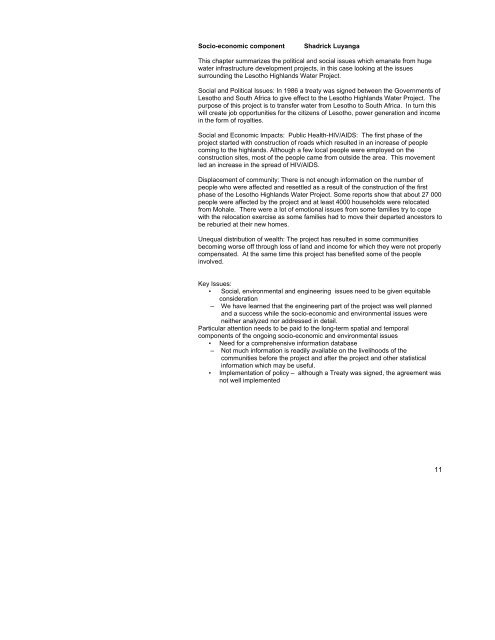An integrated assessment of socio-economic and ... - Unesco
An integrated assessment of socio-economic and ... - Unesco
An integrated assessment of socio-economic and ... - Unesco
Create successful ePaper yourself
Turn your PDF publications into a flip-book with our unique Google optimized e-Paper software.
Socio-<strong>economic</strong> component Shadrick Luyanga<br />
This chapter summarizes the political <strong>and</strong> social issues which emanate from huge<br />
water infrastructure development projects, in this case looking at the issues<br />
surrounding the Lesotho Highl<strong>and</strong>s Water Project.<br />
Social <strong>and</strong> Political Issues: In 1986 a treaty was signed between the Governments <strong>of</strong><br />
Lesotho <strong>and</strong> South Africa to give effect to the Lesotho Highl<strong>and</strong>s Water Project. The<br />
purpose <strong>of</strong> this project is to transfer water from Lesotho to South Africa. In turn this<br />
will create job opportunities for the citizens <strong>of</strong> Lesotho, power generation <strong>and</strong> income<br />
in the form <strong>of</strong> royalties.<br />
Social <strong>and</strong> Economic Impacts: Public Health-HIV/AIDS: The first phase <strong>of</strong> the<br />
project started with construction <strong>of</strong> roads which resulted in an increase <strong>of</strong> people<br />
coming to the highl<strong>and</strong>s. Although a few local people were employed on the<br />
construction sites, most <strong>of</strong> the people came from outside the area. This movement<br />
led an increase in the spread <strong>of</strong> HIV/AIDS.<br />
Displacement <strong>of</strong> community: There is not enough information on the number <strong>of</strong><br />
people who were affected <strong>and</strong> resettled as a result <strong>of</strong> the construction <strong>of</strong> the first<br />
phase <strong>of</strong> the Lesotho Highl<strong>and</strong>s Water Project. Some reports show that about 27 000<br />
people were affected by the project <strong>and</strong> at least 4000 households were relocated<br />
from Mohale. There were a lot <strong>of</strong> emotional issues from some families try to cope<br />
with the relocation exercise as some families had to move their departed ancestors to<br />
be reburied at their new homes.<br />
Unequal distribution <strong>of</strong> wealth: The project has resulted in some communities<br />
becoming worse <strong>of</strong>f through loss <strong>of</strong> l<strong>and</strong> <strong>and</strong> income for which they were not properly<br />
compensated. At the same time this project has benefited some <strong>of</strong> the people<br />
involved.<br />
Key Issues:<br />
• Social, environmental <strong>and</strong> engineering issues need to be given equitable<br />
consideration<br />
– We have learned that the engineering part <strong>of</strong> the project was well planned<br />
<strong>and</strong> a success while the <strong>socio</strong>-<strong>economic</strong> <strong>and</strong> environmental issues were<br />
neither analyzed nor addressed in detail.<br />
Particular attention needs to be paid to the long-term spatial <strong>and</strong> temporal<br />
components <strong>of</strong> the ongoing <strong>socio</strong>-<strong>economic</strong> <strong>and</strong> environmental issues<br />
• Need for a comprehensive information database<br />
– Not much information is readily available on the livelihoods <strong>of</strong> the<br />
communities before the project <strong>and</strong> after the project <strong>and</strong> other statistical<br />
information which may be useful.<br />
• Implementation <strong>of</strong> policy – although a Treaty was signed, the agreement was<br />
not well implemented<br />
11
















